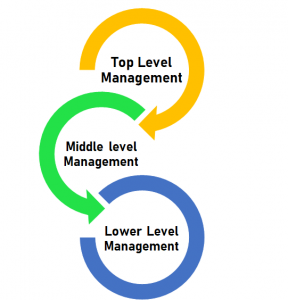Downward Communication: Advantages and Limitation
Downward Communication
Downward communication is also known as downstream communication that flows from the top-level higher authorities to the lower levels authorities in the organization the downward communication involves
- Top-level managers communicating to the middle-level managers and even lower-level managers with the organization
- The middle-level managers communicating to the lower-level managers and event to employees with the organization
- The lower-level managers communicating to their subordinates/ Employees of the organization

Essentials Elements of Effective downward communication.
- The chain of communication must be kept as short as possible to avoid loss of Information and distortion communication short chain of communication also helps to avoid delay in communication.
- Management should convey the right information to the subordinates/ Employees at the right time to improve the working of the organization. The latest changes of plans and policies of the organization should be informed to the employees.
- The management need not follow always strictly the chain of command while communicating especially in the case of urgency and important matters the information can be directly passed on to the right person.
- There should be a provision of feedback in order to make communication more effective within the organization.
- Most of all managers should learn or develop the skills of effective communication that will help to communicate effectively the right information at the right time to the right person.
Advantages of downward communication
- Provide Directions: Downward communication helps managers to give directions to the lower-level employees by sending the right messages by formal channels. Proper directions help the employees to undertake their activities essentially and effectively.
- Control of Activities: The superiors can also control the activities of their subordinates. Through a review of performance, the superior can come to know of the shortfalls or deviation with the help of downward communication the management can take proper control measures to correct and control shortfall.
- Motivate Employees: Downward communication can be used to motivate the employees to perform better through the appraisal of the employees. Encouragement and motivational talks help to motivate employees for better performance.
- Clarifications: Through effective downward communication the management can clarify the plans and policies of the organization.
- Labour Management Relations: Through effective downward communication management can develop good relations with their employees. The management can explain hard times and good times for the employees to build good relations.
- Discipline: The management can inform the organization’s rules and regulations to the Employees through downward communication, this helps to bring about discipline within the organization.
Disadvantage/Limitation of downward communication
- Delay: There is a possibility of delay in reaching the right person when downward communication flows through the line of command. To avoid this problem certain forms provide information directly to the concerned person.
- Distortion: distortion means changing something false or true information and when there is a long chain of communication the communication distortion may take place.
- Filtering: Managers may withhold sensitive or valuable information from the employees. In such a situation, the work of the organization and the relations between the management and employees may get affected.
- Dissatisfaction: The superior may try to impose their authority on the subordinates and subordinates may feel undervalued or unappreciated is resentment.
- The problem of over-emphasis: In some organizations, management may place too much emphasis on downward communication. Management may get used to only download communication. This may affect the working of the organization as little emphasis on upward communication.
- The problem of Under and over communication: The superiors may provide too little or too much information to subordinates that may affect their work.
Conclusion: Downward communication flows from the superior to subordinates within the organization. In an organization, a person from the top level of management communicates with a lower level of management.
Business Economic Notes Click Here
Reference: Manan Prakashan, Smart Notes
- Orders and directives are examples of:
a. Downward communication
b. Upward communication
c. Diagonal communication
d. Horizontal communication - Downward communication and Upward communication are :
a. Vertical communication
b. Horizontal communication
c. Diagonal communication
d. None of these - The downward communication flow from
a.A subordinate to a superior.
b.A subordinate to a subordinate.
c.A superior to a superior.
d.A superior to a subordinate.


Thank you so much sir, the article is too good in reading, understandable and easy for learning as well. Plz upload more articles..great effort!